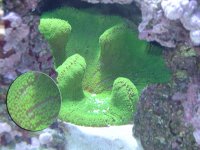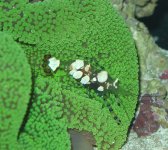To steal a line from a very funny movie, Happy Gilmore, I am having problems getting my new Amphiprion ocellaris' to take up residence in either of my anemone (green carpet & rose BTA). Is there a trick or will they eventually find their way "home"? I should mention that they are tank raised and may not know what an anemone is (is that possible)?
You are using an out of date browser. It may not display this or other websites correctly.
You should upgrade or use an alternative browser.
You should upgrade or use an alternative browser.
Are you to good for your home...?!
- Thread starter Money Pit
- Start date
well, neither of these anemone's are actually natural hosts for the clowns you have. unless the carpet is a mertenssi and not a haddoni. so if you can print a picture of a occelaris next to your tank, so that your cloowns can see them. other than that, its just kinda a 50/50 chance they will take to one of them.
IMHO clownfish are just about like women (for me)
just as soon as I think I got it figured out........
I had a Perc, and went to a bunch of trouble.. the only anemone I could get for him was a Bubble tip.. which in theory should have worked fine... the ones in the fish store were in BTAs....
I put the anemone in... two months later he had tried to live in a Sarcophytons, then a piece of red leafy Macro Algae. I think he even made a few calls about a flat in town instead of the anemone I wanted him to look at.
just as soon as I think I got it figured out........
I had a Perc, and went to a bunch of trouble.. the only anemone I could get for him was a Bubble tip.. which in theory should have worked fine... the ones in the fish store were in BTAs....
I put the anemone in... two months later he had tried to live in a Sarcophytons, then a piece of red leafy Macro Algae. I think he even made a few calls about a flat in town instead of the anemone I wanted him to look at.
Money Pit":2ly14lbd said:Anyone?
It would be impossible to ID from those pics though it is of the genus: Stichodactyla but it could be either S. mertensii or S. haddoni . We need to have a clear picture of the oral disk, tentacles, column ( base of the anemone ) and have to know whether it is situated on the rock or the substrate.
Regards,
David Mohr
I don't have any money so maybe I'd bet a beer. 
Money Pit can actually do the ID himself though like I said with pics it would be easier.
The reason I asked about where the Anemone was situated was because 95% of S. haddoni mount their base in the sand and S. mertensii mount theirs on the rock work or other hard surface frequently in a crevice. The column ( base ) on the S. haddoni is usually yellowish or tan and fairly sturdy with non adhesive wart like structures ( verrucae ) while the column on S. mertensii is white to tan, wide at the top, with adhesive verrucae at the upper portion that will hold the oral disk open by adhering to the rock, and narrower towards the bottom which is streaked with pigments longitudinally. The oral disk on S. haddoni is slightly to deeply folded, normally the same color as the column and about 500 to 800 mm in diameter with a tentacle free oral area about 10 to 20 mm while on S. mertensii the oral disk lies smoothly and can be up to 1m or more with a yellow or greenish tentacle free oral area 20 to 50 mm in diameter. The tentacles on S. haddoni are extremely sticky and it's exocolic tentacles can be up to twice as long as the endocoelic while on S. mertensii the tentacles are not as sticky and are all short 10 to 20 mm long or may have some patches that are 50mm or longer.
Regards,
David Mohr
Money Pit can actually do the ID himself though like I said with pics it would be easier.
The reason I asked about where the Anemone was situated was because 95% of S. haddoni mount their base in the sand and S. mertensii mount theirs on the rock work or other hard surface frequently in a crevice. The column ( base ) on the S. haddoni is usually yellowish or tan and fairly sturdy with non adhesive wart like structures ( verrucae ) while the column on S. mertensii is white to tan, wide at the top, with adhesive verrucae at the upper portion that will hold the oral disk open by adhering to the rock, and narrower towards the bottom which is streaked with pigments longitudinally. The oral disk on S. haddoni is slightly to deeply folded, normally the same color as the column and about 500 to 800 mm in diameter with a tentacle free oral area about 10 to 20 mm while on S. mertensii the oral disk lies smoothly and can be up to 1m or more with a yellow or greenish tentacle free oral area 20 to 50 mm in diameter. The tentacles on S. haddoni are extremely sticky and it's exocolic tentacles can be up to twice as long as the endocoelic while on S. mertensii the tentacles are not as sticky and are all short 10 to 20 mm long or may have some patches that are 50mm or longer.
Regards,
David Mohr
Here is a better picture of it's mouth. It's foot is mounted in the sand and if harassed can retreat completely (this is a big anenome) out of site. It is extremely sticky, it once got a hold of my hand and when I pulled away several of the "stingers" were stuck in my hand.








